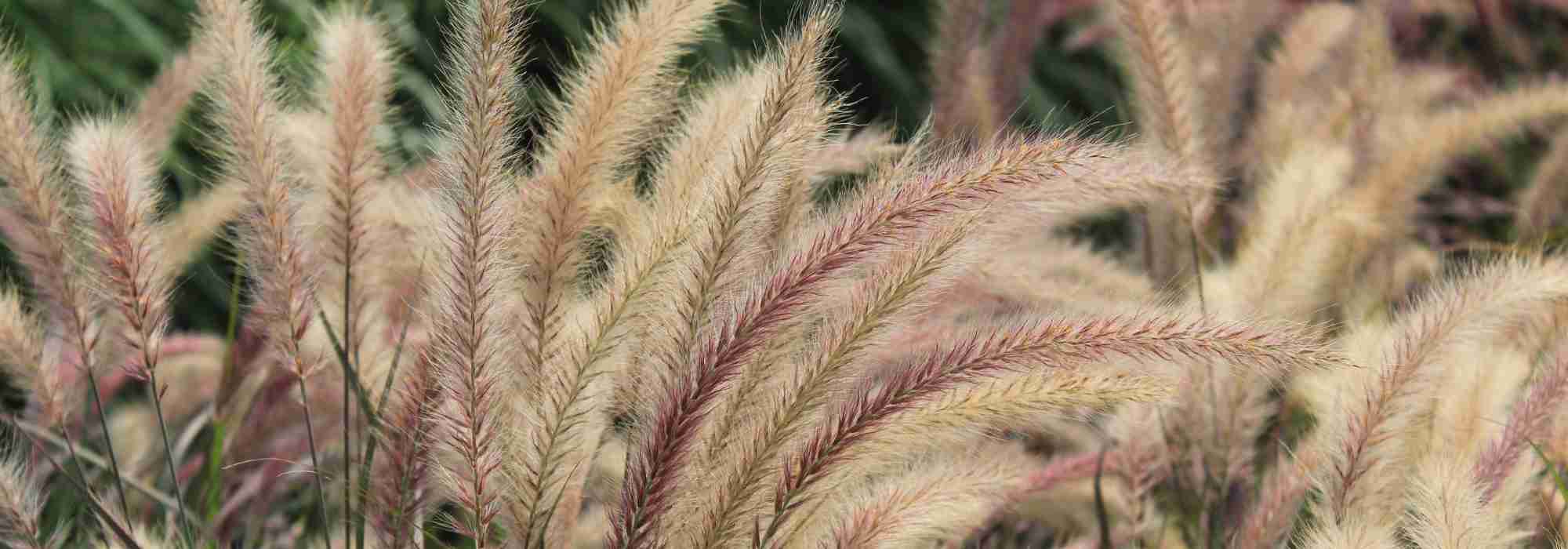
Pennisetum: 7 ideas to pairing them
In the garden or in pots
Contents
Pennisetum, also nicknamed “fountain grass”, is an ornamental grass prized for the beauty of its summer or autumn flowering in long fluffy spikes. It forms a fountain of fine foliage that remains architectural throughout the cold season, even in winter when frost coats its culms.
Very fashionable in recent years, it is often used by landscapers to add movement, lightness, a natural feel and brightness to gardens. This ornamental grass, extremely easy and rewarding to grow, is ideal for small or large sunny spaces, even in dry soil during summer.
Versatile, it suits a wild garden, the clean lines of a contemporary garden and graphic schemes, a dry or gravel garden, in borders, between stones of a large rockery, or in flowering containers. Some species can also be used as groundcover or to stabilise a dry slope.
Easy to combine, it provides a setting for many perennials without ever eclipsing the beauty of its companions — discover our pairing ideas!
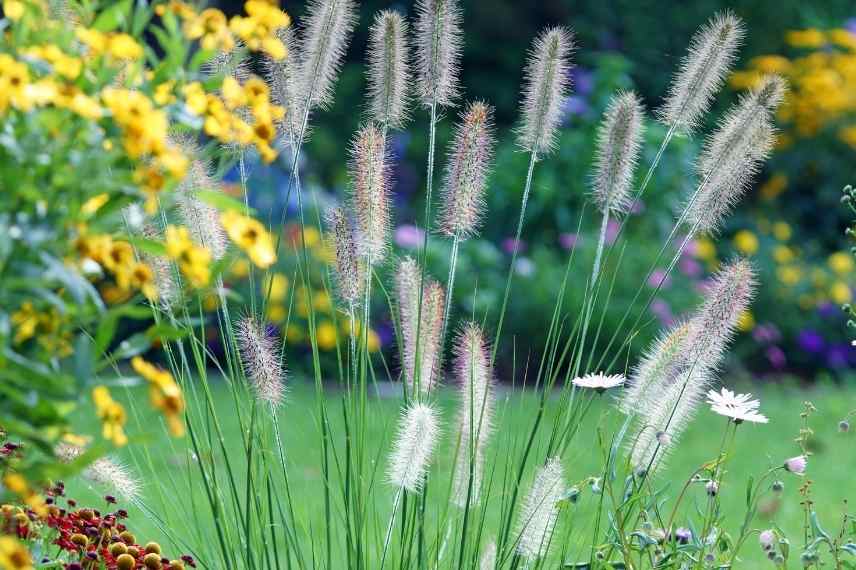
Pennisetum and Heleniums
→ Discover our comprehensive guide on Pennisetums
In a dry rockery
In rock garden, fountain grass will be perfect paired with pretty low-growing plants that, like it, love heat and tolerate summer drought well. It will easily find its place alongside autumn sedums, Eryngium planum ‘Blue Hobbit’, small grasses such as Bouteloua gracilis, Festuca glauca ‘Golden Toupee’, as well as thymes and groundcover sedums. Also consider Coreopsis and Spanish grass for a little romantic touch; in that case choose Pennisetum orientale ‘Karley Rose’ with silky pale pink-white inflorescences washed with purplish pink. It will be perfect with small hardy asters and chrysanthemums, autumn-flowering perennials.
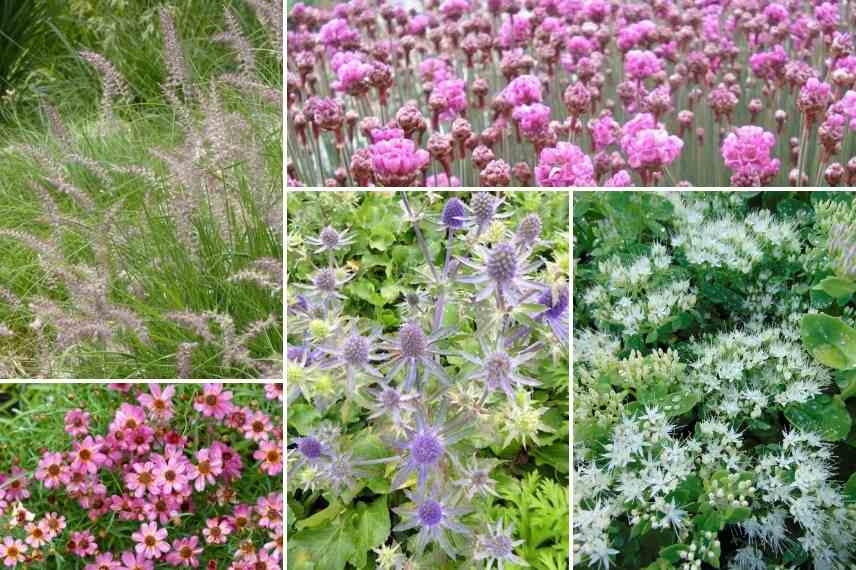
Pennisetum orientale ‘Karley Rose’, Coreopsis ‘Limerock Passion’, Armeria maritima, Eryngium planum ‘Blue Hobbit’ and Sedum spectabile ‘Stardust’
Read also
Grasses: which variety to choose?In naturalistic borders
Silky, light tufts of Pennisetum allow giving natural movement to a large border while admiring their textural and luminous effects. Choose the tallest varieties, a Pennisetum alopecuroides ‘Japonicum’ or a Pennisetum macrourum which are planted in medium or at the back of borders, to which they give a vapoury, trembling relief.
Pennisetum combines easily, coming in pit, with other perennials with summer flowering. In a lush, country-style composition, pair it with wandering plants such as Achilleas (Achillea filipendulina ‘Golden Plate’), Agastaches, Gauras and Eupatoriums, or with tall perennials such as Perovskias or Buenos Aires Verbenas, whose habit it will soften when a little stiff. It will accompany floriferous and light perennials, such as penstemons, Asters (Aster laevis ‘Calliope’, Aster turbinellus, Aster cordifolius), scabious or Nigella damascena. It lightens flowerings of heavier perennials such as dahlias, Echinaceas or Oriental poppies.
In a pink-dominated scheme, Pennisetum thunbergii with its red flowering blends perfectly with large Sedums, the small red flowers of shrub sages and those of purple Amaranths, such as ‘Velvet Curtains‘. Take advantage of its long flowering to pair it with Japanese anemones.
Punctuate these natural scenes by pairing pennisetum with tufts of Calamagrostis brachytricha or Diamond Grass, Stipa tenuifolia and why not a majestic pampas herb.
Discover other Pennisetum
View all →Available in 0 sizes
Available in 6 sizes
Available in 3 sizes
Available in 2 sizes
Available in 2 sizes
Available in 3 sizes
Available in 1 sizes
Available in 2 sizes
Available in 3 sizes
Available in 3 sizes
Path edging
Low-growing varieties can be planted along path edges. Choose, for example, Pennisetum alopecuroides ‘Hameln’ with white spikes tinged with brown, reliable choice that remains compact and doesn’t spread, or Pennisetum alopecuroides ‘Cassian’. Small red ‘bunny tails’ of ‘Red Bunny Tail’ near Allium sphaerocephalon, blue flowering of nepeta or perennial sages, a few clumps of Stipa arundinacea, and Lavender also make a splendid display. You can alternate with other grasses, the flexuous canche, Festuca mairei or Eragrostis spectabilis which will accompany them at the slightest breeze.
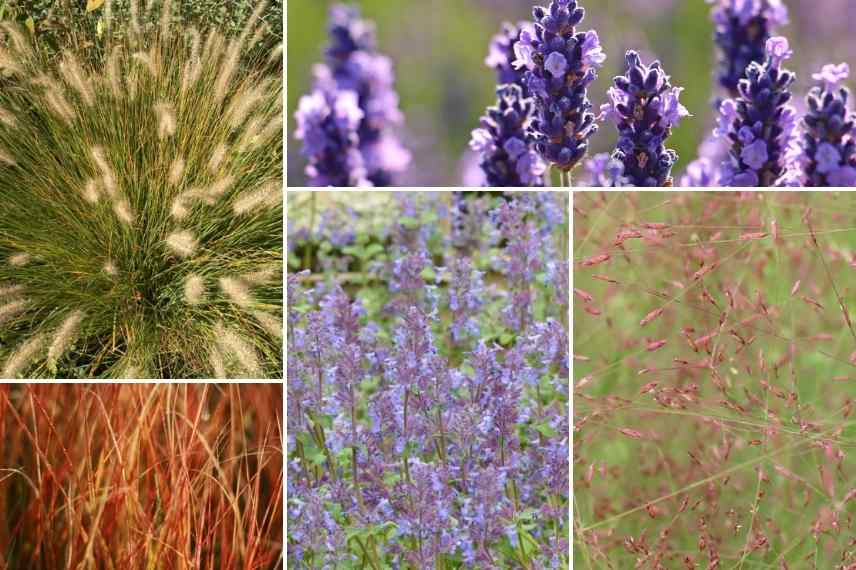
Pennisetum alopecuroides ‘Hameln’, Stipa arundinacea, Lavender, Nepeta ‘Six Hills Giant’, Eragrostis spectabilis
Read also
9 grasses for dry soilIn a wild garden
Magnificent in a wild garden, pennisetum unfurls its colourful, feathery bottlebrushes through to autumn. Once faded, they make a splendid display right through winter. That’s why it is an essential plant in naturalistic prairies to which it brings vibrant poetry. Choose a Pennisetum alopecuroides that readily self-seeds without ever becoming invasive.
Plant in large drifts; it adapts perfectly alongside meadow flowers. Its spikes will answer in a contrast of form to the large flat inflorescences of yarrow, large ox-eye daisies, and large perennials such as hybrid mulleins, Acanthus spinosus, Cephalaria gigantea or more free-form plants such as Californian poppies, hollyhocks, Dipsacus sylvestris. We recommend pairing it also with tall asters (Aster turbinellus, Aster laevis), Panicum virgatum, and Stipa gigantea to complete a pretty wild scene.

Pennisetum incomptum, hollyhocks, teasel, Verbascum, Panicum virgatum ‘Squaw’
In a contemporary garden
With its fine foliage of infinite lightness and graphic quality, the Pennisetum is also a wonderful structural plant for creating a pared-back display in a very contemporary style. It has its place in a minimalist scheme in a dry garden. In that spirit, you can place a Pennisetum setaceum ‘Skyrocket’, a variegated variety, beside a Phyllostachys aureosulcata ‘Aureocaulis’, and other tall wild herbs such as Stipa tenuifolia, Miscanthus, Mulhenbergia rigens and Panicum virgatum ‘Blue Darkness’.
In a mineral scene, it will be highlighted when surrounded by pebbles or white gravel, Allium, Hydrangea ‘Golden Annabelle’, two or three ball-shaped boxwoods and medium-sized phormium.
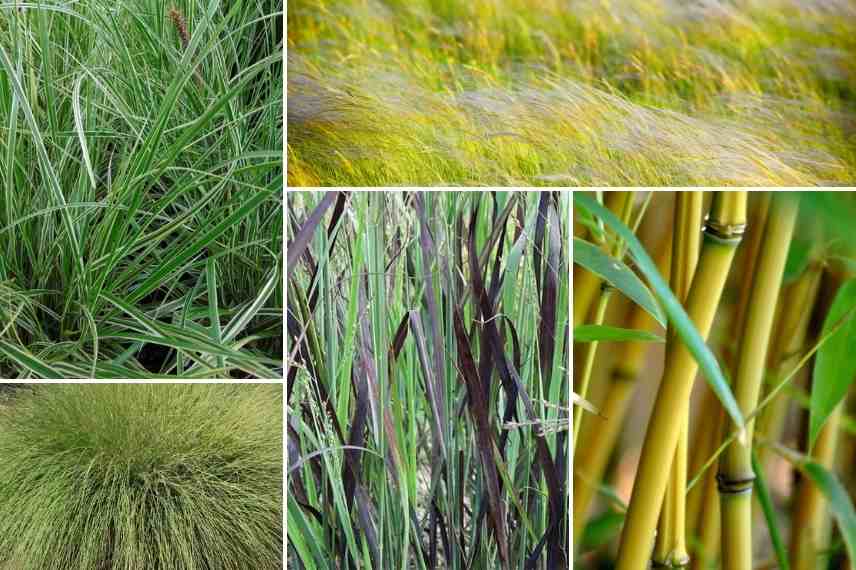
Pennisetum setaceum ‘Skyrocket’, Muhlenbergia rigens, Stipa tenuifolia, Panicum virgatum ‘Blue Darkness’, Phyllostachys aureosculcata ‘Aureocaulis’
As groundcover
Pennisetum incomptum is a species often used to stabilise dry embankments. It develops from a vigorous rhizomatous stump and eventually forms tall, upright clumps over a metre high, spreading as years go by. Ideal for reclaiming large, slightly wild areas, tolerant of exposure to wind and sea spray. Pair it with other tall grasses such as Panicum virgatum, Miscanthus sinensis, pampas grass, as well as vigorous bushes and perennials such as perovskias, large thistles (Onopordum nervosum and Berkheya purpurea), Cytisus scoparius, rockroses, lavenders and rosemary.
Potted in full sun
Some pennisetum are not hardy at all (-5 °C to -10 °C) and are most often used as annuals in summer containers, such as Pennisetum setaceum ‘Rubrum’, fully coloured from purple-red to chocolate. The Pennisetum alopecuroides ‘Goldstrich’ is a compact, original and very hardy variety that also performs well in large sunny planters. They can keep company with summer-flowering annuals (red flax, cosmos, Nigella, Diascias) or gently encircle the bases of dahlias or a Golden Cordyline to contrast the scene.
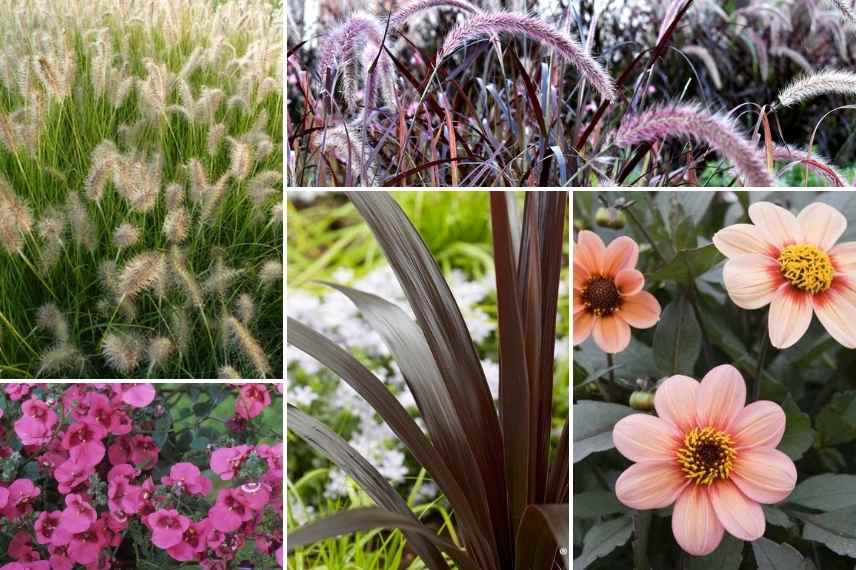
Pennisetum alopecuroides ‘Goldstrich’, Diascias, Pennisetum setaceum ‘Rubrum’, Cordyline obtecta ‘Superstar’, Dahlia ‘Happy Single Kiss’
- Subscribe!
- Contents
































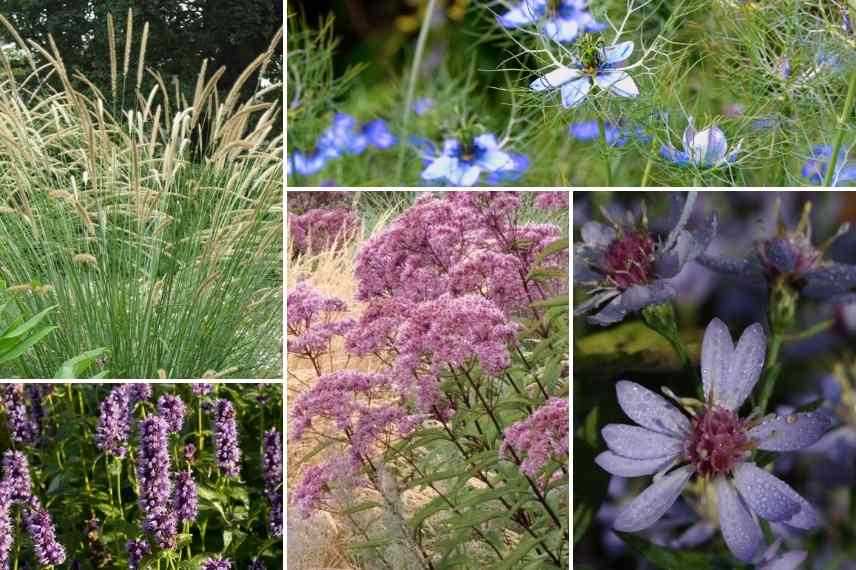
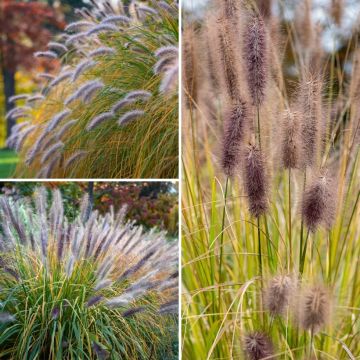
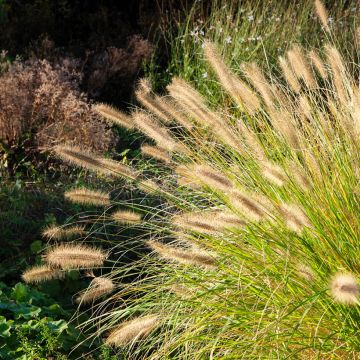
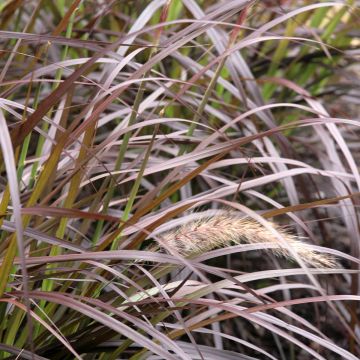

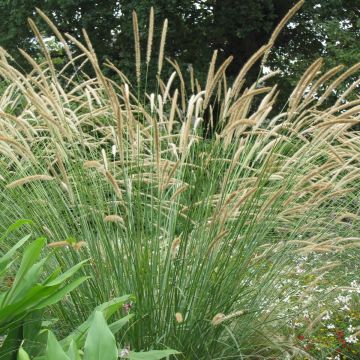
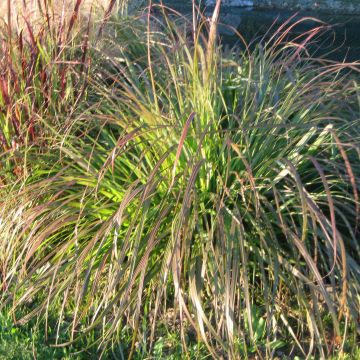
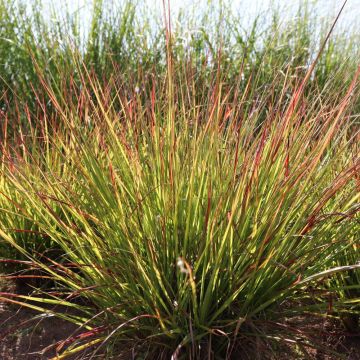
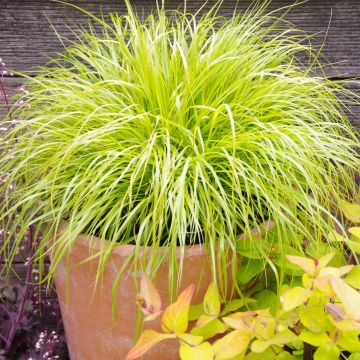
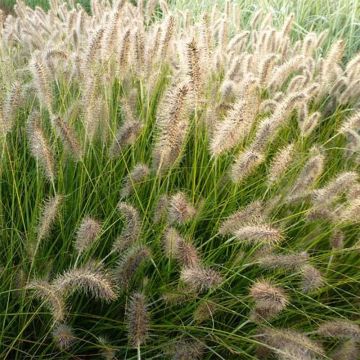
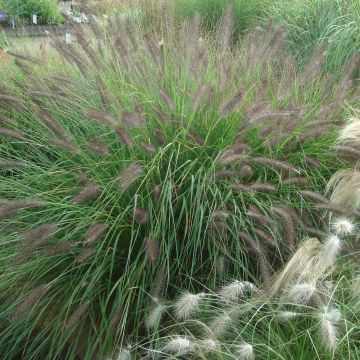

Comments